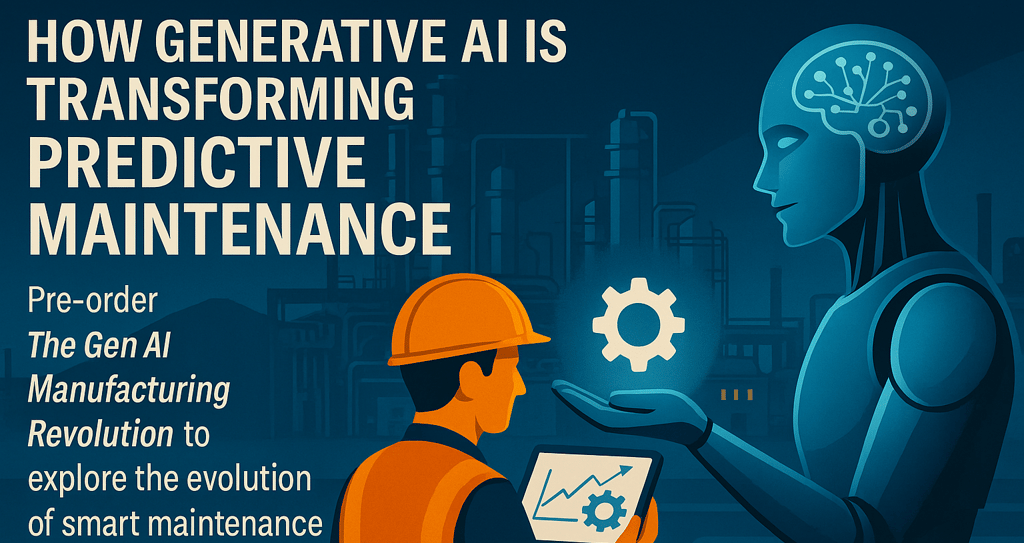What If Your Machines Could Think, Learn, and Act?
AI is no longer an experiment, it’s a competitive edge. Manufacturers face a critical crossroads. The pressure to reduce downtime, improve margins, and stay agile is unrelenting. But most still treat AI as a tool for the future, rather than a driver of value today. That’s why I wrote The Gen AI Manufacturing Revolution, a practical playbook for manufacturers ready to transform. In my latest article, I explore one of the book’s core themes: how generative and agentic AI can help factories not only survive, but thrive, especially during planned shutdowns, supply chain shocks, and workforce gaps. From intelligent monitoring during line transitions to predictive workflows that cut downtime in half, the opportunity is real and urgent.
Matthew Alberts, PhD
7/26/20252 min read


A Sneak Peek into the Next Industrial Evolution, and Why You Should Preorder The Gen AI Manufacturing Revolution
Manufacturing is no stranger to automation. From steam-powered looms to the robotic arms of Industry 4.0, progress has always come from finding ways to do more, faster, with fewer resources. But now, a new wave is rising, one not just built on efficiency but on intelligence.
This isn’t just another step forward. It’s a leap. And the leap is agentic AI.
From Predictive to Agentic: Why the Game Is Changing
In The Gen AI Manufacturing Revolution, I outline a shift that few manufacturing leaders fully grasp, but those who do will dominate the next decade.
We’ve grown accustomed to predictive AI, systems that forecast failure, suggest maintenance, or anticipate quality issues. Useful? Absolutely. But limited.
What comes next is agentic AI: systems that don’t wait for instructions. They understand intent, evaluate context, and take initiative.
They don’t just tell you that something might go wrong.
They:
Pause the affected line to prevent a cascading failure
Reroute production through alternate machines
Communicate with inventory systems to assess backup availability
Trigger service tickets, notify operators, and even update delivery estimates
Agentic systems are autonomous, contextual, and collaborative.
“This is machine empathy, not emotion, but awareness. Awareness of purpose, surroundings, priorities. Your machines become teammates, not tools.” -Excerpt from Chapter 7: The Rise of Machine Empathy
Why Machine Empathy Isn’t Sci-Fi, It’s the Future of Competitive Edge
If you’re a plant manager, engineer, or executive, think about your next scheduled shutdown.
How many hours will you spend coordinating system diagnostics? How much risk lies in the startup phase? How many tribal knowledge shortcuts keep your operation afloat?
Now imagine this:
A digital twin that maps every interdependency
An AI agent that monitors each critical asset for pre-start anomalies
A system that adapts your SOPs based on current machine health, not a checklist from six months ago
This is not speculative.
These systems already exist. What’s missing is broad understanding and adoption.
Why This Book Matters, and Why You Need It Now
The Gen AI Manufacturing Revolution is more than a book. It’s a playbook designed for leaders who want to move from AI pilot projects to AI-powered operations.
Inside, I walk through:
Real-world use cases from early adopters in the manufacturing sector
The anatomy of agentic AI systems
Practical frameworks to audit your AI readiness
How to overcome data silos, talent gaps, and change resistance
Ethical considerations in AI governance and decision-making
And yes, how to avoid getting stuck in “pilot purgatory”
Why You Should Preorder
This book isn’t meant to sit on a shelf, it’s meant to sit on your desk, guiding your next investment, initiative, or plant-wide transformation.
Preorder now and be among the first to reshape how your factory thinks, learns, and evolves.
